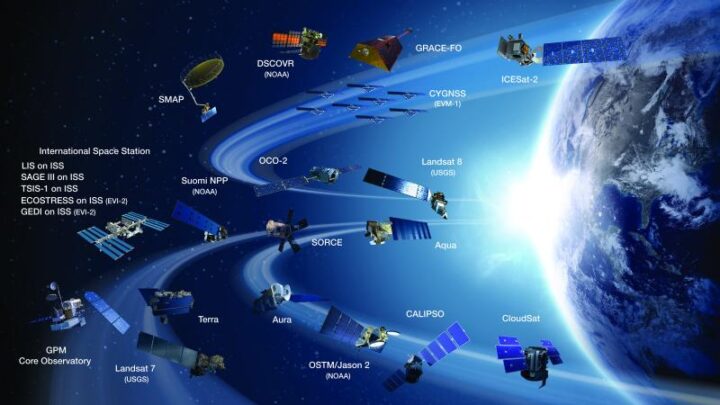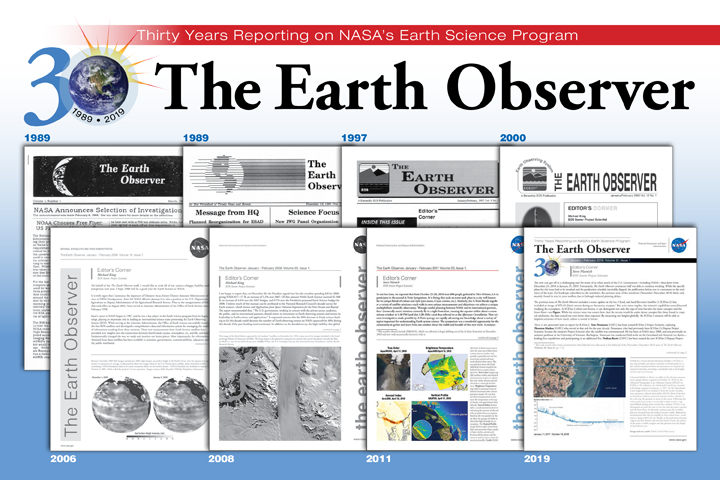The March–April 2019 issue marks the thirtieth anniversary of the release of the first issue of The Earth Observer newsletter in March 1989. Alan Ward has spent much of his career working on this publication—including 13 years as Executive Editor—and has written a reflection to mark this milestone. The following version has been edited for length. You can read the full story here.
Spurred on by the successes of pioneers in satellite remote sensing, in the early-to-mid-1980s a concept emerged to obtain coordinated Earth observations from space. The earliest designs envisioned having several large platforms in orbit, each carrying many instruments, that could be serviced via the Space Shuttle, akin to how the Hubble Telescope was reserviced. However, that approach eventually morphed into the present fleet of small-to-mid-sized satellites launched on unmanned rockets: e.g., Terra, launched on an Atlas IIAS rocket; Aqua and Aura, both launched on Delta II rockets. The idea was given a name: the Earth Observing System (EOS).

Making EOS a reality would require a fundamental shift in how scientists studying Earth approached their research. Traditionally, individual science disciplines tended to focus on their own areas of expertise, and only occasionally worked together. The idea behind EOS was to study the Earth as a system of interrelated systems—an approach that came to be known as Earth System Science. Functionally, that meant that scientists from different disciplines would need to collaborate much more frequently than they had in the past.
In short, EOS was a grand vision: that we’d someday have a fleet of satellites (along with complementary ground observations and computing systems) continuously taking the pulse of our home planet and sending back large amounts of data—and that scientists would come together to work on related topics. But just how would it all work in practice? No one knew for sure back then. Ask anyone who attended early EOS meetings what they were like and they are likely to use words such as “chaotic” and “challenging” to describe them. In an article he wrote for The Earth Observer, Darrel Williams [former Project Scientist for Landsat 7, currently Chief Scientist at Global Science & Technology, Inc.] recalled that Pier Sellers once described the overall experience of trying to take EOS from idea to reality as being, “…like putting socks on an octopus.”
Sellers definitely had a unique way with words. Whatever creative metaphor one might use to describe it, there is no doubt that those first EOS investigators had huge challenges before them! Not only did they have to work out the details of the flight hardware and computing systems for EOS almost from scratch, but they also had to figure out the practical details of how they would actually work together.
As challenging as developing space flight hardware was (and still is), at that time there was an even larger logistics issue that needed to be addressed. A huge program involving hundreds of researchers strewn all over the nation—and eventually the globe—was trying to get off the ground, and the participants needed the means to communicate. The Internet, which we take for granted today, was in its infancy at that time. If you wanted to get the word out about upcoming meetings, results from those meetings, announcements, and the like, print media was still the way to go. Enter The Earth Observer!
Thirty Years Chronicling NASA Earth Science
Space does not permit the full story of the intimately interconnected history of the evolution of The Earth Observer and EOS to be repeated here. For this context, it suffices to say that the idea, or concept of EOS faced a difficult journey—and evolved a great deal—before it became what it is today, and that, from its inception, The Earth Observer has chronicled that story.
By the time I made my first contribution to The Earth Observer in 2001, the EOS Earth observing satellite fleet was beginning to take shape. Terra had been launched only a couple years earlier and the other flagship missions (Aqua and Aura) would follow in the next three years. During my tenure, I’ve watched the EOS Program come of age. The Earth Observer has chronicled the establishment and now graceful aging of members of NASA’s Earth-observing fleet of satellites, and has also reported on airborne and ground-based sensors.
We continue to report on NASA Earth Science as we move beyond the EOS era into the Suomi NPP and JPSS era, and into other endeavors such as Decadal Survey missions, including the Earth Venture element. We’ve reported on the launches of new (or recently launched) missions along the way, as well as on the remarkable scientific achievements of existing platforms as, one by one, they exceeded their planned mission lifetimes—often by many years—and celebrated a decade or more in orbit.
I noted earlier that EOS wasn’t simply a satellite-based program. The Earth Observer has also reported on the complementary ground elements, describing results from field campaigns and other ground-based observation programs over the years.The Earth Observer has also published feature articles on more-general topics, such as Earth Science Mission Operations, responsible for keeping the fleet flying safely, and Earth Science Data Operations, which includes the EOS Data and Information System, better known as EOSDIS.
Perhaps the series I take the most personal pride in is our Perspectives on EOS series, which ran from 2008 through 2011. It really didn’t begin with a series in mind; it started with an article that I wrote for the newsletter’s twentieth year, and grew organically into a compendium of recollections and memories from key members of the EOS program. It is often said that history is the telling of a personal story, and that was certainly true with these articles, as the storytellers had actually lived them.

In many ways, the current publication doesn’t look much like the first issue did in March 1989, shortly after the official beginning of EOS. However, while much has changed aesthetically and in terms of content in 30 years, The Earth Observer’s core commitment remains the same as it has always been: to report timely news and events from NASA’s Earth Science Program.
It has been my honor to serve as executive editor for a baker’s dozen of years, and I look forward to seeing what comes next for The Earth Observer as we begin our fourth decade. I think it’s been a good run so far—but I hope our best is yet to come!



